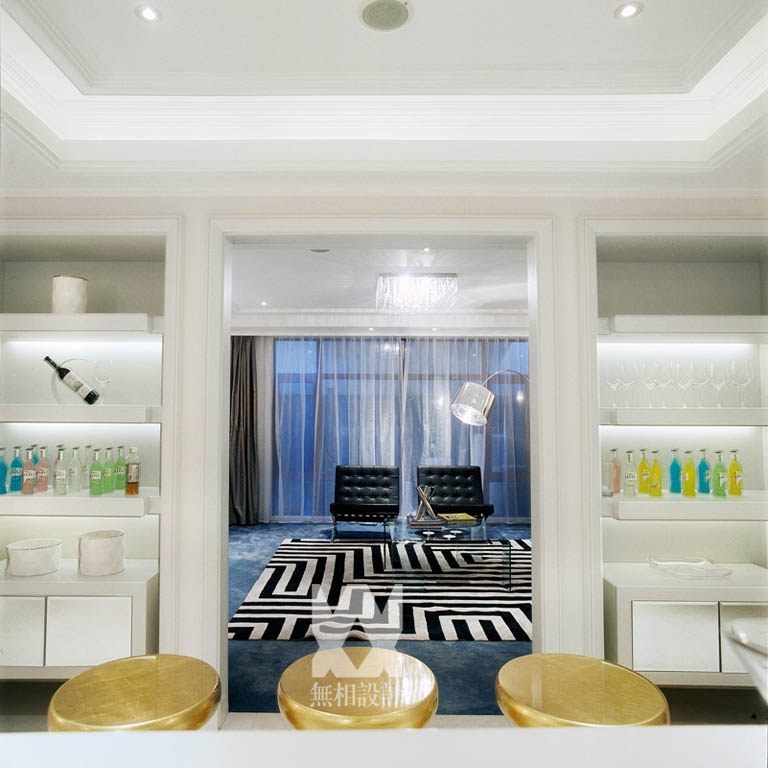new perspectives in dining nendo presents colourful shadows at japans expo milan 2015 pavilion
2015-06-16 11:52
Oki Sato's design studio Nendo has designed an all-white dining space within Atsushi Kitagawara Architects' Japan Pavilion at Expo Milano 2015. Photography: Daici Ano
2015年世博会日本馆的“日本馆”是一个安静的全白用餐空间,由国家设计冠军OKISATO的工作室NENDO设计。
作品标题为“五颜六色的阴影”,作品包括一个倾斜的黑色餐桌,周围有一套24个匹配的椅子,并铺设了一排黑色的餐具,跨越了11M×3m的空间。
随着游客的进入,家具的高度逐渐增加,产生扭曲的视角,鼓励客人使用椅子作为梯子,以便更仔细地查看显示器上的物体。
与世博会的主题“给地球喂食,能量为生命”相关,16件餐具都由工作室设计,并通过不同的日本传统工艺或当地产业制作。
“在小说家Junichiro Tanizaki的《赞美阴影》中,”Nendo解释了节目名称背后的想法,“有一段关于在黑暗中吃一个YOKAN(一种传统的豆豉做的甜食)的文章,为了开发一个更敏锐的调色板。正如本次展览一样,所有有关颜色的信息都已被移除,以鼓励观众关注展品的其他更重要的方面。
In the centre of the space, a sloping black dining table, surrounded by a set of 24 matching chairs, is laid with an intriguing array of 16 pieces of black tableware. Photography: Daici Ano
As visitors walk into the space, the furniture gradually increases in height – guests are encouraged to use the chairs as stepladders to get a closer look at the objects on display. Photography: Daici Ano
The perspective-bending dining space correlates with the Expo's underlying theme of ‘Feeding the Planet, Energy for Life’. Photography: Daici Ano
Sixteen pieces of black-coloured tableware were designed by the Japanese studio and produced via a different traditional Japanese craft or local industry – so as not to distract from the intricacies of the craftsmens' work, the pieces are all black. 'Tokoname-yaki' by Koyo (pictured). A set of Japanese confectionery-shaped coasters are produced using Tokoname-yaki – a type of reddish-brown ceramic ware chiefly produced in Tokoname, Aichi Prefecture. Photography: Hiroshi Iwasaki
'Yamanaka-shikki' by Japan Crafts Oshima. Used to make this rippled bowl, Yamanaka-shikki is a type of lacquer ware which originated in the late 16th century in the Yamanaka Onsen (hot spring) region in Kaga, Ishikawa Prefecture. Photography: Hiroshi Iwasaki
'Imari Arita-yaki' by Gen'emon Gama. Umekomon plum blossoms, stripes, checkers, and floral patterns have been hand drawn onto the matte surface of these 'ochoko' cups by skilled craftsmen in Arita, Saga Prefecture using a newly developed glossy glaze. Photography: Hiroshi Iwasaki
'Ozu-washi' by Ikazaki Shachu. In this piece, sumi, a black ink used in traditional calligraphy which is compatible with Japanese washi paper, has been mixed in to soften the paper, and then compressed to form the shape of a small plate. Photography: Hiroshi Iwasaki
'Satsuma-yaki' by Tsukino-mushi. Incorporating the distinctive black used in traditional Satsuma earthenware – a colouration that comes from the iron in the clay and glaze – this bowl features a citrus fruit motif, a matt finish on the exterior and a glossy finish on the inside. Photography: Hiroshi Iwasaki
These pleated 'Wakasa-nuri' chopsticks by Hashikura Matsukan are designed to be more comfortable to hold in the hand. Photography: Hiroshi Iwasaki
This set of 'Wakasa-nuri' chopsticks by Hashikura Matsukan were made using a careful process of carving, polishing and lacquering. Photography: Hiroshi Iwasaki
'Oodate-magewappa' by Oodate Kougeisya. The 'Oodate-magewappa' is a wooden box, usually circular or oval in shape and made from bending cedar or cypress. With this particular item, the container has deliberately not been made into a complete cylinder so, depending on its size, it can be used as a chopstick holder, a toothpick holder, or a chopstick rest. Photography: Hiroshi Iwasaki
'Edo-kiriko' glassware, often cited as a local specialty of Tokyo, originated in 1834. This set of 'Edo-kiriko' glasses by Kimoto Glassware is made using a simple two-layered cylinder of transparent and black glass, etched with single horizontal or vertical cut. Photography: Hiroshi Iwasaki
The traditional Japanese 'masu', or box-measure, has been widely used for centuries as a cup from which to drink sake, and as a measuring device for various grains. This particular masu has been produced in collaboration with Kahei Yamada, an Edo-style woodwork craftsman who practices a sophisticated technique that dates back to the early Edo Period. The boxes' top and bottom have been tapered with diagonal carvings for easier stacking. Photography: Hiroshi Iwasaki
'Edo-sashimono' for Kahei Yamada. With a history of more than 1300 years, Mino-yaki is a type of pottery and porcelain from the Tono region in Gifu Prefecture. By combining this with the traditional technique of kintsugi, which is the art of repairing broken ceramic ware with a glue lacquer, three identically shaped but different-coloured plates have been cut and refitted to form these unique designs. Photography: Hiroshi Iwasaki
This matching teapot and cup by Gasen are made using 'Yamagata-imono', a type of cast-metal craft from Yamagata Prefecture, which has its roots stretching back to the mid Heian Period. Photography: Hiroshi Iwasaki
A set of four eggshaped bowls are made by Tsukino-mushi using Satsuma-yaki – a type of ceramic ware from Kagoshima Prefecture, originating in the times of Lord Toyotomi Hideyoshi. Photography: Hiroshi Iwasaki
A set of interlocking chopsticks made using Wakasa-nuri (lacquerware) by Hashikura Matsukan. For four centuries, the town of Obama in Fukui Prefecture, Japan, has manufactured lacquerware and is reknowned for its expertly crafted lacquered chopsticks. Photography: Hiroshi Iwasaki
These placemats are made from recycled shipping maps using a traditional luxury 8th century textile-making technique called Nishijin-ori, often woven to make obi belts for kimonos. Crafted by Hosoo, the traditional brocade is created from thinly cut strips of paper (in this case, shipping maps) that have been treated with lacquer or gold leaf. Photography: Hiroshi Iwasaki
Made from aluminium treated with a urethane baking finish this cutlery set is made by the craftsmen at TakataFactory who specilaisse in 'Takaoka-doki' – a type of cast metalwork specific to Takaoka in Toyama Prefecture. Photography: Hiroshi Iwasaki
keywords:Nendo, Expo Milano 2015
 举报
举报
别默默的看了,快登录帮我评论一下吧!:)
注册
登录
更多评论
相关文章
-

描边风设计中,最容易犯的8种问题分析
2018年走过了四分之一,LOGO设计趋势也清晰了LOGO设计
-

描边风设计中,最容易犯的8种问题分析
2018年走过了四分之一,LOGO设计趋势也清晰了LOGO设计
-

描边风设计中,最容易犯的8种问题分析
2018年走过了四分之一,LOGO设计趋势也清晰了LOGO设计







































































